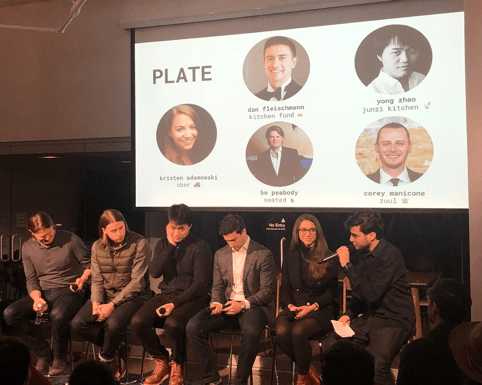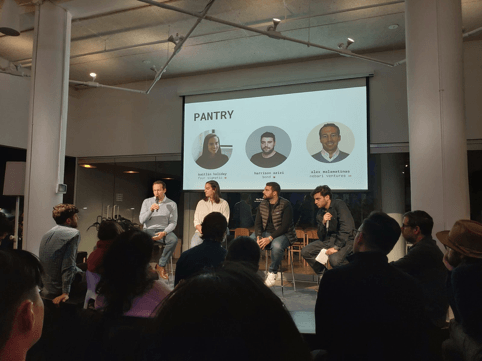Editor’s Note: Matt Newberg is the founder of HNGRY, a new media platform exploring how technology shapes the way people eat. He has spent the last eight years working in tech as a product manager and entrepreneur, most recently at Vimeo. He is now combining his passion for food with tech to host a blog, video series, and events.
It took Amazon nearly two and a half decades to capture 5% of the world’s retail. If that period was about layering technology on top of the physical world, the next will be digital-first, physical second. Two weeks ago, I hosted 130 hungry New Yorkers at Betaworks Studios for “Plate & Pantry 3.0,” a discussion about how this new paradigm is unfolding across the food CPG and restaurant landscapes. This event was part of HNGRY, my new media platform exploring how technology shapes the way people eat.
The first panel featured Nebari Ventures, mushroom-based drinks startup Four Sigmatic, and offsite retail tech company Bond sharing predictions and experiences about the next generation of digitally-native food and beverage brands. Here are my main takeaways:
Direct-to-consumer (DTC) brands are finding new creative ways to acquire customers as social and search become overcrowded
“It’s about not putting all your eggs in the Facebook, Instagram, and Google basket,” said Kaitlin Holliday, head of e-commerce and data for Four Sigmatic. “In the golden age of paid media, everyone was trying to get that arbitrage against the algorithm; it’s just too good now.” Instead, Four Sigmatic has geared its marketing strategy towards podcasts, influencers, and affiliates.
“Old school, traditional marketing is making a comeback,” said Alex Malamatinas, managing partner of Nebari Ventures, who sees brands succeeding with traditional billboards and TV ads. “Brands definitely need to be creative to be successful.”
Growth requires maintaining an omnichannel presence outside of pure DTC
“Ultimately, our north star is we want to be where the customer is,” said Holliday. “If you prefer to be on Amazon, we want to be there for you. We found that around a third of our customers online have purchased us elsewhere.”

The second panel was focused on the implications of delivery and reservation apps becoming a larger intermediary in the dining experience. Panelists represented a range of these apps Seated, Uber Eats, Kitchen Fund, Junzi Kitchen, and Zuul Kitchens. Here are the main takeaways:
The growth of off-premise sales has driven average capacity for sit-down restaurants to just 46%
“I knew from my other life that the reason that frequency is going down is because people have a lot of options on delivery, meal kits, on-demand grocery, high-end QSR,” said serial entrepreneur Bo Peabody, venture partner at leading VC Greycroft and founder/chairman of Seated. “I started Seated to have something on the other side because convenience is what drives these other things. Take one extra night and go back into the restaurant and have the experience that the chef and restaurateur wanted you to have, that’s what Seated is about.”
Ghost kitchens are high risk for unestablished restaurant concepts
Dan Fleischmann, VP at Kitchen Fund, walked the audience through his math behind ghost kitchens which, despite their hype, are actually costly to operate. His research finds that a restaurant would have to generate at least $650,000 in sales to breakeven in a ghost kitchen. This dampens the promise of ghost kitchens hosting new delivery-only concepts, in favor of established brands that have more demand than their current stores can meet.
“It’s unfortunate, but it’s also a reality that restaurants are their most effective means of marketing,” explained Zuul Kitchens CEO, Cory Manicone.“I think we’ll start to see less brick and mortars throughout the city and more delivery appendages.” It’s a catch-22.
Food is looking a lot more like eye-catching content than a dish from a restaurant
Last year, Uber Eats launched two branded virtual restaurant campaigns for Rachael Ray and Breaking Bad’s Los Pollos Hermanos. Expect to see more of these.
“I think it’s really interesting because with the rise in these [third-party] delivery platforms, they’re like a newsfeed,” explained Kristen Adamowski, head of virtual restaurants for Uber Eats. “From that perspective, I think a lot of brands are seeing this as an advertising space.”
Look no further than China to get a glimpse into what ghost kitchens could look like at scale
“I think Chinese food has been here in America for over 50 years. It’s one of the [old school] delivery foods,” said Junzi Kitchen founder Yong Zhao. “Before the Uber Eats, Grubhub era, Chinese people delivered their food. What’s behind it is actually self-exploitation of immigrants that work hard [to] make sure their food is delivered conveniently and cheaply.”
Ghost kitchens have existed for a while in mainland China, where e-commerce behemoths like Meituan Dianping have succeeded at delivering food at a lower cost than dining in at a restaurant.
“There are things we can learn directly from China and apply them here and find new opportunities,” explains Zhao. He estimates a $30 billion opportunity for Chinese food in the US.
“There are so many salad brands, they have to find new ways to compete with each other. That’s why we think omnichannel Chinese food is such a unique opportunity; 80% of their sales are off-premise, 95% of their customers are local people, not Chinese.”
Catch up on the full panel below.




